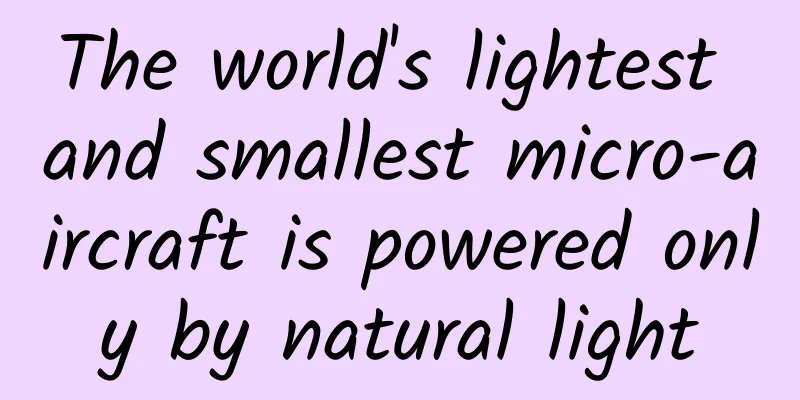The world's lightest and smallest micro-aircraft is powered only by natural light

|
Produced by: Science Popularization China Author: Shi Chang (PhD in Physical Chemistry) Producer: China Science Expo Editor's note: In order to understand the latest developments in cutting-edge science and technology, the China Science Popularization Frontier Science Project has launched a series of articles titled "Understanding Top Science Journals", which selects outstanding papers from authoritative journals and interprets them in plain language as soon as possible. Let us broaden our scientific horizons and enjoy the fun of science through the window of top journals. When it comes to aircraft, what comes to mind may be huge airplanes or drones that take beautiful photos for us during travel. Drones appear more and more frequently in our lives. Their compact appearance and high-definition cameras have gradually become a "magic" for many photography enthusiasts. But do you know that the lightest aircraft currently weighs only a few grams, which is a few hundredths of the weight of a drone, and can last for dozens of minutes. Drones (Photo source: veer photo gallery) Micro air vehicles, a new breed of low-altitude flying vehicles Micro Aerial Vehicles (MAVs) are extremely small (no more than 50 cm) and light (no more than 100 grams) aircraft, which are usually used to perform reconnaissance, monitoring, communication and other tasks in complex environments. They not only have the flight capabilities of traditional aircraft, but also have a small size and flexibility, showing great application potential in many fields such as military and civilian. Energy supply is crucial in micro-aircraft. Due to the size and weight restrictions, micro-aircraft have extremely high requirements for batteries. At present, the energy supply systems of micro-aircraft mainly include lithium batteries, hydrogen fuel, solar energy, etc. Solar panels (Photo source: veer photo gallery) Lithium batteries are the most commonly used energy source in micro-aircraft. They have the characteristics of high energy density and light weight, and are very suitable for micro-aircraft that require long flight time and lightweight design. Hydrogen fuel can generate heat energy by mixing with high-pressure gas and burning it, driving micro-turbine engines to power aircraft. Hydrogen has the characteristics of low density and high energy release when burned, which can provide higher thrust and higher power for micro-aircraft. For example, the button-sized micro-turbine engine developed by the Massachusetts Institute of Technology can achieve extremely high speed and light weight. Solar energy may be one of the solutions to solve the problem of micro-aircraft endurance. Since the working environment of aircraft is usually outdoors, solar energy can be fully utilized to power them and achieve the demand for long-term endurance. In addition, with the development of solar power generation technology, hybrid energy supply has gradually been applied to the field of micro-aircraft. Through solar power generation, excess electricity is stored in lithium batteries to provide energy guarantee for micro-aircraft. Although solar power generation technology is sustainable, it is difficult to increase the flight time of micro air vehicles due to their size limitations and low energy conversion efficiency. New breakthrough in micro-aircraft, weighing only 4.21 grams, and capable of sustainable flight On July 17, 2024, Chinese scientists published a research paper on the ultra-light aircraft (CoulombFly) in the journal Nature. The aircraft weighs only 4.21 grams, making it the lightest solar-powered aircraft currently available and can fly continuously under the sun. The research results were published in the journal Nature (Image source: Nature magazine) The ultra-light aircraft is mainly composed of an electrostatic drive propulsion system and an ultra-light kilovolt power system, which is also the key to its sustained flight. Powerful power system: The electrostatic drive propulsion system consists of an electrostatic motor and a propeller. An electrostatic motor is a device that uses static electricity (immobile electric charge, generated by friction, contact or induction) as an energy source to convert electrical energy into mechanical energy. Its working principle is that when high-voltage direct current is applied to the electrode plate of the electrostatic motor, a high-voltage electric field is generated inside the motor. Under the action of the electric field, the blades of the motor rotate continuously, thereby driving the rotation of the propeller and driving the aircraft into the air. Ultralight aircraft; b. Aircraft in a flight test system; c. Takeoff and sustained flight of an aircraft exposed to sunlight (Image source: Reference 1) Ultra-light power supply system: The ultra-light kilovolt power system consists of a high-voltage power converter and solar cells. Solar cells can generate low-voltage DC power under natural light, but low-voltage DC power cannot directly drive the motor. Therefore, the researchers designed a high-voltage power conversion device that can convert 4.5 volts of low-voltage DC power into 4000-9000 volts of high-voltage power to meet the working requirements of the electrostatic motor. In addition, the ultra-light kilovolt power system weighs only 1.13 grams and has a voltage-to-mass ratio of 7.09 kilovolts per gram, which is much higher than the lightest kilovolt high-voltage generator currently available. a. High-voltage power converter and solar cell; b. Circuit design of high-voltage power converter; c. Relationship between output voltage and frequency of high-voltage power converter; d. Power conversion efficiency curve (Image source: Reference 1) The experimental results show that the micro-aircraft, which weighs only 4.21 grams, has an energy consumption as low as 0.568 watts. The aircraft was tested under natural light conditions for 1 hour, with almost no performance degradation and can fly continuously. In addition, the micro-aircraft can have a lift of 5.8 grams at a voltage of 8.5kV. Minus its own weight, it can also carry an additional load of 1.59 grams. It can carry light actuators, sensors and control electronics, and can achieve autonomous operation in the future. What are the application areas of micro air vehicles? Civilian field: Micro-aircraft can be used for meteorological monitoring, environmental monitoring, ocean monitoring and natural disaster monitoring, etc., providing important data for environmental protection and disaster warning. In complex environments such as mountainous areas and earthquake-stricken areas, micro-aircraft can search for lost or injured people and provide guidance for search and rescue operations. Micro aerial vehicles have high maneuverability and flexibility, and are expected to be used in terrain mapping and aerial photography in the future. Drone spraying pesticides (Photo source: veer photo gallery) Conclusion With the continuous advancement of technology and the continuous expansion of application scenarios, the development prospects of micro-aircraft will be broader. We have reason to believe that in the future, micro-aircraft will appear in every corner of our lives with a more intelligent, flexible and efficient appearance, creating a safer, more convenient and better living environment for us. References: 1.Guicherd, M., Ben Khaled, M., Guéroult, M. et al. An engineered enzyme embedded into PLA to make self-biodegradable plastic[J]. Nature, 2024. 2.Jafferis, NT, Helbling, EF, Karpelson, M. et al. Untethered flight of an insect-sized flapping-wing microscale aerial vehicle[J]. Nature, 2019. 3. Li Zhanke, Song Bifeng, Song Hailong. Research status and key technologies of micro air vehicles[J]. Flight Mechanics, 2003. 4. Yue Jilong, Zhang Qingjie, Zhu Huayong. Research progress and key technology analysis of micro quadrotor UAV[J]. Electro-Optics and Control, 2010. |
<<: Want to eat all the crayfish? First figure out: where are you eating crayfish from?
>>: On the Qixi Festival, let’s look at the plants that symbolize love in the Book of Songs.
Recommend
Drinking too much water can lead to "water poisoning"? Is it advisable to drink a lot of water in the game of flying flowers and spinning dice?
gossip In many people's minds, drinking more ...
Russia's "General" debuts in Dubai, the Su-75, priced at 30 million per unit, will challenge the United States in the fighter jet market
DUBAI, United Arab Emirates - With a laser light ...
Appeared in Fujian 96 million years ago? The largest Deinonychus was found from footprints!
In the winter of 2020, a team from China Universi...
Medicinal effects of the saro tree
The Sala tree is regarded as a sacred tree in Bud...
Solanum nigrum anti-cancer
When it comes to Solanum nigrum, many people may ...
The efficacy and function of travertine
The medical value of travertine is beyond our ima...
The efficacy and function of Tongmaidan
Most Chinese medicinal materials have good effect...
What are the effects of Qinjiao
Normally, the adverse reactions caused by bacteri...
The efficacy and function of tangerine cake
Friends who don’t know tangerine cake will not un...
The efficacy and function of milk vertebra
Chinese medicinal materials are very common, and ...
Urgent reminder! Don’t eat this kind of fruit on the roadside!
Summer is here It's fruit season again Especi...
Weaving a "giant net" to peer into the universe, how precise is the square kilometer radio telescope array?
Author | Zhou Jihao Audit | Huang Jian Editor | Z...
The distance between you and stargazing experts is just this guide
Loading long image... Source: National Geographic...
How to take L-carnitine
Many women are trying to lose weight, especially ...









